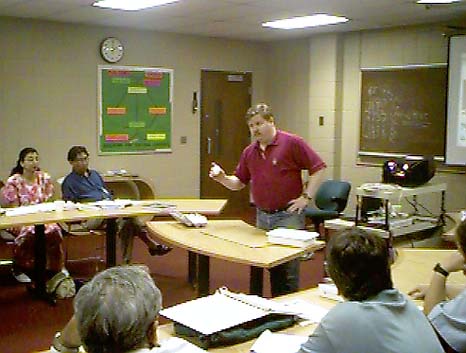
By way of introduction for today I will say only what the X-Files says- Trust No One. According to popular belief on the web, radium boils at anywhere from 1140-1737 degrees Celcius. Maybe not. But "The Truth is Out There". Right? Ahhh.... no. We still do not have confirmation on the boiling point of the element radium. The first experiment of the day was and analysis of eggs. Eggs, known only by their letter/number name were passed out to the class. Their instructions were to determine the content of the eggs. By the end it became apparent that a few of the methods worked better than others. Shaking the eggs and listening for "sloshing" sounds seemed to be quite effective for determining whether the contents were liquid or non-liquid. The tried and true wobble and fall down methods also came into play when determining the contents of the eggs. What tripped people up was that a few of the eggs' contents were neither solid (hard boiled) or liquid (raw). Some of the eggs were actually filled with liquid soap, which has some of the test results from both the solid and liquid camps. And who could anticipate eggs being filled with something other than egg? This experiment helped in demonstrating both the scientific method and the fact that we are biased by our assumptions, and thus miss the truth entirely in some cases. From there it was on to straws. Each group was given a box of straws and told to make certain predictions about the contents of the boxes based on the information given on the outside of the box. Many people stuck to their guns about the fact that "any company would put at least as many, if not more, than the amount stated on the box to avoid legal trouble, and to put more than the stated amount would be a waste of money". This is true, but it might be more expensive to try and parcel EXACTLY the right number of straws or make them EXACTLY the right length or width. The many who believed in the companies were disillusioned this day. Out of seven boxes three had exactly forty, two had forty-two, and two had thirty-nine. This is quite an improvement from last year, where we discovered the average number of straws to be less than stated on the package. Dr. Warner began his segment by using an example from his daughter's algebra book to illustrate the problems in today's education system. One of the problems that he addressed was the fact that students were not being schooled in what units that they should be using in their word problems, and thus in their models. Word problems, being the most common models that students face, serve as both an introduction to modelling and as a spawning ground for bad habits and confusion. Dr. Hirst began her portion by reviewing the scientific method, but with a modelling twist. The steps go as follows: identify the problem, formulate the model (units, etc.), obtain the solution (remember, it is the solution to the MODEL, not the problem), interpret the solution (did it make sense?), and compare the solution with reality (was the answer sensible? do the answers agree with the predictions? has it fulfilled its purposes? is it accurate enough?). From there you continue to circle back to the beginning if any of the last questions had an answer of no. We then proceeded to use the scientific method to determine different aspects of dropping rabbits (stuffed, of course).
 |